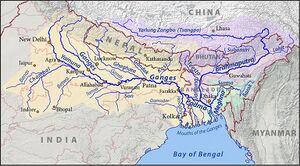Subansiri River
| Author:Laxman Burdak, IFS (R) |

Subansiri River (सुबनसिरी नदी) is a trans-Himalayan river and a tributary of the Brahmaputra River that flows through Tibet's Lhünzê County, Shannan Prefecture and the Indian states of Arunachal Pradesh and Assam.
Variants
- Subansiri (सुबनसिरी)
- Swarna Shri (स्वर्णश्री)
- Swarna Shri River (स्वर्णश्री नदी)
Origin of Name
Subansiri derives name from two sanskrit words Swarna (स्वर्ण) + Shri (श्री).
The name is derived from a Sanskrit word svarṇa (स्वर्ण), meaning 'gold'.[1]
The name Subansiri originates from the fact that this river was a potential site for gold mining in the past. The name Subansiri is derived from the Sanskrit word 'swarn' which means gold.[2]
Originally the name applied to the river only after the confluence of the Chayul Chu and Tsari Chu rivers at Gelensiniak.[3] In early maps of independent India, Tsari Chu was marked as the main Subansiri river. However, over time, the name has been transferred to Chayul Chu. Within Tibet, the rivers are named after the locations they flow from such as Loro Chu, Nye Chu, Char Chu and Chayul Chu, all of which apply to the Subansirir or its tributaries.
Course
The Subansiri is 442 kilometres long, with a drainage basin 32,640 square kilometres.[4] It is the largest tributary of the Brahmaputra contributing 7.92% of the Brahmaputra's total flow.[5]
The Subansiri River originates in the Himalayas near Mount Porom in the Tibet.[6]
It enters India near the town of Taksing and flows east and southeast through Miri Hills,[7] then south to the Assam Valley at Dulangmukh in Dhemaji district,[8]where it joins the Brahmaputra River at Jamurighat in Lakhimpur district. Small tributaries of the Subansiri include Rangandi, Dikrong and Kamala.[9]
The Subansiri lends its name to two districts in Arunachal Pradesh: Upper Subansiri and Lower Subansiri.
सुबनसिरी नदी
सुबनसिरी नदी (Subansiri River) भारत के असम व अरुणाचल प्रदेश राज्यों तथा तिब्बत में बहने वाली एक नदी है, जो ब्रह्मपुत्र नदी की सबसे बड़ी उपनदी है। यह तिब्बत में हिमालय में आरम्भ होती है और पूर्व व दक्षिणपूर्व दिशाओं में बहती हुई भारत में प्रवेश करती है, जहाँ यह असम के लखीमपुर ज़िले में ब्रह्मपुत्र से संगम करती है। सुबनसिरी का पानी ब्रह्मपुत्र में बहने वाले जल का 7.92% मापा गया है। अरुणाचल प्रदेश के ऊपरी सुबनसिरी और निचले सुबनसिरी ज़िलों का नाम इसी नदी पर रखा गया है।
नामोत्पत्ति: "सुबनसिरी" का नाम संस्कृत के "स्वर्ण" व "श्री" शब्दों को जोड़कर उत्पन्न हुआ था। इतिहास में इस नदी के किनारे सोना ढूंढा जाता था।[10]
External links
References
- ↑ Goyal, Manish; Gupta, Shivam; Sarma, Arup; Singh, Dhruv (2017). "Subansiri: Largest Tributary of Brahmaputra River, Northeast India.". In Dhruv Sen Singh (ed.). The Indian Rivers: Scientific and Socio-economic Aspects. Springer. pp. 523–535. doi:10.1007/978-981-10-2984-4. ISBN 9789811029844. LCCN 2017940312. S2CID 187246753. p. 523.
- ↑ "The Indian Rivers: Scientific and Socio-economic Aspects," Manish Kumar Goyal, Shivam, Arup K Sarma, Dhruv Sen Singh; Springer Hydrogeology Series, Springer, 2017, ISBN 9789811029844
- ↑ Goyal et al. 2017, p. 523.
- ↑ Rao, K.L. (1979). India's Water Wealth. Orient Blackswan. p. 78. ISBN 978-81-250-0704-3.
- ↑ Singh, Vijay P.; Sharma, Nayan; Ojha, C. Shekhar P. (2004). The Brahmaputra basin water resources. Springer. p. 82. ISBN 978-1-4020-1737-7.
- ↑ Goyal et al. 2017, p. 523.
- ↑ Goyal et al. 2017, p. 523.
- ↑ Barman, Swapnali; Bhattacharya, R.K.; Sharma, S.K.; Tirkey, G. (February 2020), Future flow scenario of Subansiri River and its Impact on Power Potential of Subansiri Lower Hydro Electric Project (PDF), IIT Roorkee and NIH Roorkee
- ↑ Goyal et al. 2017, p. 523.
- ↑ "The Indian Rivers: Scientific and Socio-economic Aspects," Manish Kumar Goyal, Shivam, Arup K Sarma, Dhruv Sen Singh; Springer Hydrogeology Series, Springer, 2017, ISBN 9789811029844, ... The name Subansiri originates from the fact that this river was a potential site for gold mining in the past. The name Subansiri is derived from the Sanskrit word 'swarn' which means gold ...
Back to Rivers

